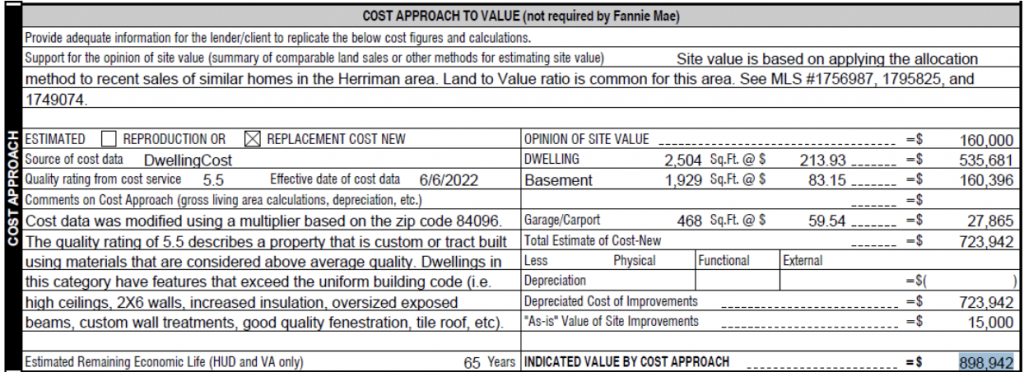If you’re new to real estate investing, you’ve probably heard the term “cost approach” used in appraisals. But what is the cost approach? The cost approach is a method of valuing a property that considers the land value, the depreciation of improvements (buildings and structures), and the replacement costs of said improvements. Understanding how this method works can assist you in making informed decisions about your real estate transaction.
What Does The Cost Approach In Appraisals Mean?
The cost approach to appraise a property is based on the principle that the value of a property equals the replacement cost of the structure plus the value of the land. The method is most often beneficial for non-income-producing properties, such as vacant land, residential, and commercial properties.
The approach takes into account all the costs associated with building a new property of comparable size and features, including the purchase price of the land, the cost of construction, and any applicable fees. It is important to note that the cost approach does not account for any depreciation or appreciation in the property’s value over time.
The cost approach is not as widely used as other approaches to property valuation in Utah, such as the sales comparison or the income approach. It can, however, be a useful tool in determining the value of a property that is not selling on the open market.
For example, if you’re looking to buy a new home and want to know its worth, you could use the cost approach to get a ballpark figure. Remember that the value determined by this method may differ from the sale price of a recently sold property.
How Does The Cost Approach Take Into Account Depreciation And Other Factors?
- The cost approach considers an asset’s physical deterioration and functional and economic obsolescence.
- It also assigns a monetary value to land, which other approaches do not.
- Furthermore, the cost approach considers the costs of buying and selling a home. These costs may include real estate commissions, legal fees, and title insurance.
- Finally, the cost approach computes the present value of the property’s future cash flows. This includes rent or lease payments, income from operations, and any capital appreciation or depreciation.
How Can You Increase The Value Of Your Home Using The Cost Approach?
You can use the cost approach to increase the value of a home in a few ways.
- First, you can improve the property to increase its functionality or appeal.
- Second, you can cut the costs of owning and running a home. This could include lowering energy consumption or increasing the property’s efficiency.
- Finally, you can try to increase the home’s future cash flows. This could include renting out extra space or raising the rent.
Examples Of How The Cost Approach Is Used In Practice
The cost approach is often used in divorce settlements, estate planning, and other legal proceedings. It is also commonly used to value businesses and other commercial properties. This method can provide a more accurate estimate of a property’s value because it considers all future cash flows.
Here is an example of what the cost approach could look like in an appraisal report:
 Factors That Can Influence The Estimated Value Of A Property
Factors That Can Influence The Estimated Value Of A Property
When appraising a piece of property, there are many factors that can influence the estimated value. Some of these factors are objective, such as the size and condition of the property. Others are more subjective, such as the appraiser’s personal opinion of the property or recent comparable sales in the area.
For example, the estimated value may get affected if a property is significantly larger or smaller than most in the area. The property’s condition can also play a role; the appraiser will most likely appraise a property that needs repairs at a lower value than one in good condition. Finally, recent comparable sales in the area can give the appraiser an idea of how much the property might sell if it went on the market.
When Can You Apply Cost Approach
- New Construction
- The method is used to determine the worth of new construction. You can use it if you’ve never sold or occupied a property and don’t have any comparable sales data to determine its market value. To calculate the cost of a building, you must first determine how much it cost to construct it. Then you can use that figure to project how much the building would sell for on the open market.
- Divorce Settlements
- The cost approach can be helpful for calculating the value of a property that is being divided as part of a divorce settlement. It can provide a more accurate estimate of the property’s value than other methods.
- Estate Planning
- The cost approach can be used to calculate the value of a property that is being transferred as part of an estate. This can help ensure that the property is fairly valued.
- Unique Use Properties
- Special use properties are those that are not comparable in terms of their condition, location, and utility. The appraiser will make assumptions about the cost of replacing the property with a comparable one.
- They then calculate the fair market value of the fee simple interest in the property by adding the replacement cost to the amount depreciated. This method is frequently used when valuing intellectual property, such as copyrights and trademarks.
- Insurance Appraisals
- The cost approach is one of the most important methods an insurance company can use when appraising an insurance loss. This method calculates the replacement cost of the lost or damaged property.
- It is also critical to use this method because it considers the current market value of the property and the cost to replace it. This data can be extremely useful in determining the value of an insurance claim.
What Are The Benefits Of Using The Cost Approach?
- The cost approach is the most conservative of the three methods and is often used when little or no market data is available.
- The cost approach is also useful for not being actively traded properties, such as owner-occupied homes.
- By using the cost approach, an appraiser can estimate a property’s value by looking at the costs associated with acquiring and developing the property. This gives a more accurate estimate of a property’s value than other approaches, which may rely on past sales data.
- The cost approach reflects the actual price a buyer would pay for the property. This is because it considers all the costs associated with replacing the property.
- The approach is objective and unbiased. It does not take into account personal preferences or opinions about a particular property.
- The appraiser can also use cost calculation to determine if a property has been overvalued or undervalued. If the replacement cost is lower than the sale price, the property has been undervalued. If the replacement cost is higher than the sale price, the property has been overvalued.
- Appraisers can use it to assess property damage. The appraiser can calculate how much it would cost to repair or replace the damaged property.
Are There Any Drawbacks To Using The Cost Approach?
- The main drawback of the cost approach is its complexity. It can be difficult to calculate all future cash flows and assign a value to them.
- This approach can also be less accurate than other methods, especially in cases where the market value of a property has changed significantly since it was originally purchased.
If you are a property owner or appraiser, you must understand the fundamentals of the cost approach in appraisals. This method estimates a property’s market value by calculating the costs of replacing it.
Learn More About The Cost Approach
If you’d like to learn more about the cost approach, need help with an appraisal, or are still wondering what the cost approach is, don’t hesitate to get in touch with us right away. If you’re interested in a free quote, call us at 1-801-882-2292! We would be delighted to assist!
